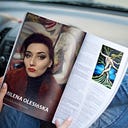Franz Kline — Abstract Expressionist and Action Painting
“Franz Kline was born on May 23, 1910, in Wilkes-Barre, Pennsylvania. He studied painting and drawing at Boston University (1931–35), and drafting and illustration at the Heatherley School of Fine Art, London (1937–38). After returning to the United States, he settled in New York, where he produced traditional cityscapes and interior scenes and, in the early 1940s, won awards at several National Academy of Design Annuals.Kline soon began experimenting with small black-and-white brush drawings after Willem de Kooning introduced him to abstraction. At the end of the decade, De Kooning’s use of a Bell-Opticon projector inspired Kline to project his brush drawings onto his studio wall, transforming them into large-scale ideograms. These experiments marked the beginning of Kline’s characteristic abstractions incorporating powerful lines and rapidly developed gestures of black paint on white ground. Compositions such as Wotan (1950–51) prompted speculation about the influence of East Asian calligraphy on Kline’s practice; he denied these claims, stating that he fully intended the images to evoke the known or recognizable while avoiding literal references. Kline employed intense tonal contrasts, often working at night under strong light. His use of housepainters’ brushes produced tiny splatters and inflections on the canvas that enhanced the explosive quality of his black lines.”
